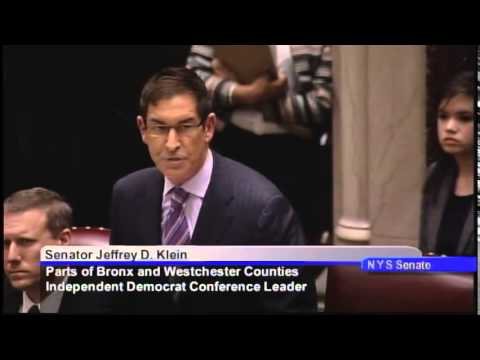
Independent Democratic Conference Report Illustrates a New Deal for New York Will Revitalize NYS Infrastructure and Create Good Paying Jobs
Jeffrey D. Klein
February 26, 2015
Labor Organizations and Advocates Applaud IDC’s Plan to Inject Billions from Bank Settlements into Community Rebuilding Across the State
ALBANY, NY - State Senator Jeff Klein (D-Bronx/Westchester) and members of the Independent Democratic Conference released a New Deal for New York report with detailed new job creation projections on Thursday. The New Deal for New York plan was immediately met with praise from leaders and non-profit executives as the wisest way for New York State to invest $5 billion in financial settlements. The IDC predicts the creation of more than 130,000 good-paying new jobs through its plan.
Modeled on President Franklin D. Roosevelt’s New Deal, the two-pronged proposal invests $5 billion in financial settlements in infrastructure projects and boosts employment through the creation of the Empire Public Works Revolving Loan Fund (EPW) and a Community Jobs Program (CJP). The IDC anticipates the EPW would create 97,000 new jobs and the CJP would generate 40,000 more employment opportunities.
“A New Deal for New York will help revitalize our crumbling infrastructure while providing a hand up for thousands of New Yorkers who want nothing more than the opportunity to work, save, and provide for their families. This plan takes a page out of the Roosevelt era that helped lift millions of Americans out of the shadows during the Great Depression and modernizes it to meet the challenges of a 21st century workforce. We have the sufficient resources and labor at our disposal and I am confident this plan will have a positive ripple effect throughout our state for many years to come,” said Independent Democratic Conference Leader Jeff Klein.
With $3.5 billion, the EPW invests in projects through a revolving loan fund and creates thousands of private sector jobs. Under the proposal large, long-term infrastructure projects such as roads, bridges, rail and transit projects, along with antiquated water and sewer systems in dire need of repair are eligible for funding. As a revolving loan it maximizes the amount of financeable infrastructure. In other words, the state would be in the position to invest and subsequently reinvest the money in worthy projects for years to come. The minimum amount for a loan is $250,000 while the maximum is $750 million.
Such eligible projects for financing include the replacement to the Tappan Zee Bridge in the Hudson Valley, along with other projects under the direction of the Metropolitan Transportation Authority (MTA), Upstate Transit Authorities, local governments, and state agencies and public authorities. In addition, regulated utilities along with local water and sewer districts could also apply to fund upgrades to their systems. All projects financed through the creation of the EPW will fall under existing public contracting laws and regulations including prevailing wage statutes.
Empire Public Work's Revolving Loan Fund | |
Amount of Public Spending | $3.5 Billion |
Cost per Direct Job Estimates | $77,000 to $92,000 |
Amount of Direct Jobs Created | 38,500 to 45,500 |
Amount of Total Jobs Created | 84,000 to 97,300 |
The plan also calls for using $1.5 billion for the creation of a Community Jobs Program to provide individuals with good paying jobs and adequate job training while investing in local projects such as rebuilding parks, libraries, and other small business development projects.
The IDC’s Community Jobs Program (CJP) complements this investment by focusing on bringing individuals into the workforce who have been marginalized from it or have had trouble entering the workforce. Modeled off of the original WPA, this program finances smaller projects and administers grants as opposed to a loan program. The IDC calls for a one-time allocation of $1.5 billion, with a minimum grant amount of $50,000 and a maximum of $10 million.
In recruiting new workers, the CJP will ensure that any project awarded meets the criteria outlined. Project recipients must demonstrate in their applications how they plan to hire the long-term unemployed, individuals on public assistance, and those who are trying to enter the workforce for the first time. This will ensure that our most vulnerable populations in today’s workforce are not left behind. At the same time, CJP will give slight preference to projects in counties with an unemployment rate higher than the statewide average, along with lower income communities.
Additionally, projects financed through the CJP must meet existing prevailing wage requirements, as the IDC believes New York State should not spend public monies to create lesser paying minimum wage jobs. Regional Wage Boards would establish the rates of pay for those individuals not covered by existing labor laws mandating a prevailing wage and would take into account local variations in pay scales to match incomes to different costs of living.
Community Jobs Program | |
Amount of Public Spending | $1.5 Billion |
Cost per Direct Job Estimates | $77,000 |
Amount of Direct Jobs Created | 19,480 |
Amount of Total Jobs Created | 41,700 |
“The New Deal for New York will do great deal for New Yorkers who want to work. This investment is an not only a powerful engine for job growth, but will upgrade archaic infrastructure and spur new economic development projects,” said Senator Diane Savino (D-Staten Island/Brooklyn).
“New York’s infrastructure is the backbone of our state, and is critical to not only the health and quality of life of New Yorkers, but to our economic development efforts statewide. The ‘New Deal’s’ plan will wisely invest settlement funds in updating and expanding our infrastructure while creating jobs in the process,” said Senator David Valesky (D-Oneida).
“Residents of my home borough of Queens know better than anyone how hard New York was hit by the recession. These settlement funds provide an opportunity to continue down our path to recovery, and to reinvest in New York. With A New Deal for New York, we can bring our state back to the forefront of economic opportunity. Through the Empire Public Works and Community Jobs Programs, we can develop our infrastructure, strengthen our workforce and revitalize our communities,” said Senator Tony Avella (D-Queens).
“Investing in infrastructure not only creates good paying, quality jobs, it keeps our families safe by ensuring that we are keeping up with the wear and tear on our roads. The Tappan Zee bridge project is serving as an economic engine for Rockland, Westchester, and the State of New York. The New Deal for New York program allows us to apply for funds and finish the Tappan Zee bridge, while keeping our tolls affordable,” said Senator David Carlucci (D-Rockland/Westchester).
The plan has received the support of various labor organizations and nonprofit groups who applauded the call for an immediate and substantial investment to rebuild New York's antiquated infrastructure and put people back to work:
Mario Cilento, President of the New York State AFL-CIO, said: “The IDC's plan for infrastructure development includes smart labor protections for workers and taxpayers alike. From prevailing rate to Buy American preferences to training requirements, the New Deal for New York helps ensure that we’re creating good jobs, not poverty jobs, and building the highest quality roads, bridges and mass transit systems. In addition, in order to strengthen our economy and communities, we must also invest in education, critical state services, and aid to municipalities, which have been cut to the bone over the last several years.”
John Samuelsen, President of Transport Workers Union Local 100, said: “Senator Klein offers a once in a generation public works program that stands to positively impact transit expansion projects and the entire manufacturing supply chain. On the transit side alone, A New Deal for New York could spark manufacturing of rolling stock in New York while forging ahead with transit supply chain items such as bus engine equipment, tires, and so much more. This plan goes well beyond iron and steel, and just based upon MTA procurement alone, it will create thousands of good paying jobs for working men and women. Now is the time to make this critical investments in our infrastructure that will reap dividends for years to come.”
James Cahill, President of the NYS Building & Construction Trades Council, said: “On behalf of the 200,000 members we represent, the NYS Building & Construction Trades Council applauds Senator Klein’s plan which combines infrastructure investment with workforce development. The Building Trades has always been the backbone of New York’s middle class, and those hired through this program will join those ranks by learning skills that will provide them with a lifetime of opportunity. We look forward to working with the legislature to ensure that these funds, and all public funds, are distributed through bidding procedures that include robust worker protections.”
Gary LaBarbera, President of the Building and Construction Trades Council of Greater New York said: "The New Deal for New York proposal is the type of thinking that’s needed to continue growing our state’s economy. It not only invests in New York's infrastructure with critical improvements to roads, bridges and mass transit, but also strengthens our state’s middle class by providing good paying jobs for working men and women.”
Allison Sesso, Human Services Council Executive Director said: “The human services sector is an integral component to the economic stability and growth of our State, and the cornerstone of healthy communities. The people we serve represent all walks of life and come through our doors for a vast variety of essential services. We not only provide individuals with bridges to opportunity, but also act as important job supports. We contribute to the economy by buying goods and services and by employing thousands of workers. Nonprofits employ 15 percent of the State’s workforce, and our workers are 80 percent women and 80 percent people of color. Carving out a portion of the surplus to be used flexibly by nonprofits for infrastructure and technology investments is a smart and worthwhile investment by the State given its reliance on these organizations to provide billions of dollars’ worth of social services.”
Bich Ha Pham, Federation of Protestant Welfare Agencies Director of Policy, Advocacy and Research said: “Transitional jobs and wage subsidy programs like the Community Jobs Program help the unemployed and those with barriers to employment receive job training and move to permanent jobs. Quality permanent jobs and consistent work mean that more men and women will move upward. It makes good business sense that a portion of the State's $5 billion settlement funds be used to help both those struggling to make ends meet and improve their circumstances.”
Jeffrey S. Leb, Managing Director, Government and External Relations for UJA-Federation of NY, said: “UJA-Federation of NY applauds every effort to recognize the value and needs of the non-profit sector. Clearly an investment of the uniquely available settlement dollars in the infrastructure projects of non-profit agencies will benefit New Yorkers for many years to come”

